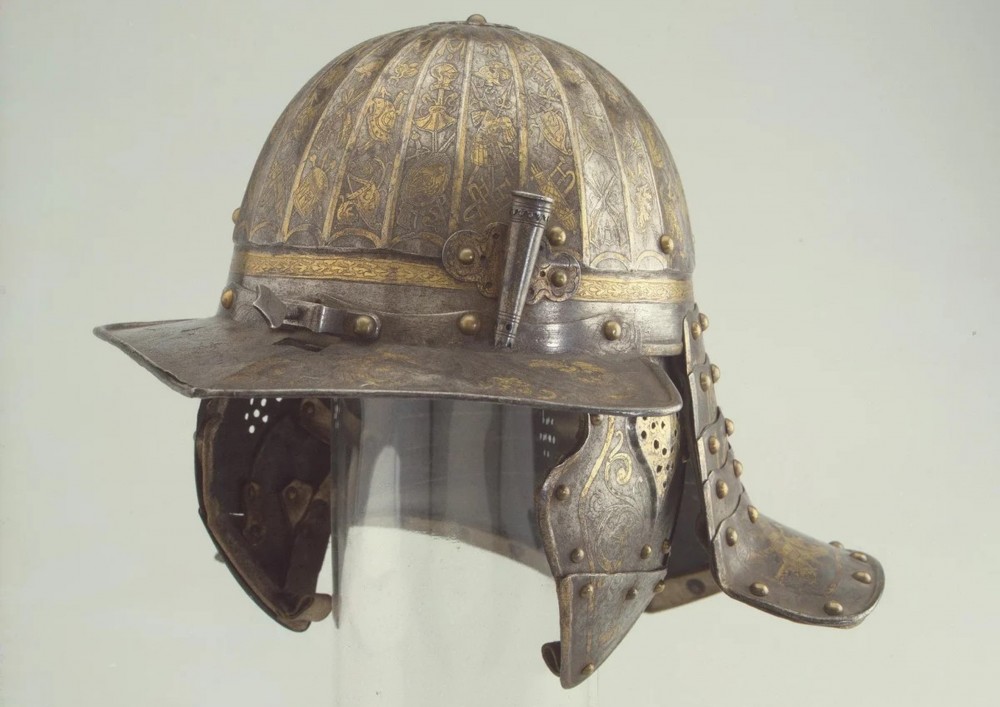
The analyzed iron helmet (inv. № 2698) is kept in Museum of Archeology and Ethnography of Siberia of Tomsk State University. It was found during the earthworks at the foot of Voskresenskaya mountain (Tomsk city) in 1889. Previously this helmet didn’t become the object of the independent scientific research. Judging by the material of manufacture the helmet refers to the class of the iron ones, by the construction of the crown — to the department of the riveted ones, by the shape of the dome — to the type of the hemispherical ones. The total height — 15,5 om, the frontal-occipital diameter — 23,9 om, the temporal one — 20,3. The weight of the helmet is 1,8 kg. The crown was riveted from two halves (the connecting seam is situated at the line «the forehead-the occiput»). Herewith the left half overlaps the right one slightly. The most part of the crown is covered with 16 vertical stiffening ribs. The plates of the crown bend and transform to the wide twofold peak (the length — 25 tm, the width: 5,2 — 7,0 nl) at the frontal part of the helmet. The plume holder and the plate neck-flap “crayfish tail” saved fragmentarily are riveted to the occipital part of the helmet. The rivets with the hemispherical heads on the crown and the neck-flap were made from the copper alloy. The characteristic holes in the helmet testify that it was urnished with the nasal, the knob and the earpieces. The surface of the helmet has mechanic damages. Some of them can be the tracks of the chops and the enemies’ arrows’ impact. It was found under the typological analysis that the helmet refers to the “German-Flemish” type of the European model’s sisaks. The distinctive feature of these helmets was the low ribbed crown riveted from two halves transforming to the very wide twofold peak. If the helmet of MAES TSU was made by European (presumably South German) armorers the most likely date of its manufacture should be considered the 20-40ies of the 17th century. It could be appeared at the territory of Moscow state both as the war trophy and among other weapon bought by tsar government for the equipping of Russian reiters at the 30ies — the beginning of the 60ies of the 17th century in Western Europe. But the sisak could be forged directly at the territory of Muscovy. In last case the helmet can date from the middle of the 17th century that is from the time of cavalry armor’s mass production of the Western European sample at the Russian weapon manufactures. The helmet was delivered to the territory of Siberia privately or within the framework of the armor’s state supply intended to equip the warriors of Siberian cities. According to written sources the armor of the European type was become to use by Tomsk service people no later than at the middle of the 30ies of the 17th century. Most likely that the helmet belonged to the officer or the warrior-cavalryman at the moment of its being in Tomsk. The sisak from MAES TSU is among 11 helmets of Russian and European production discovered at the territory of Siberia and it has the considerable scientific value.
Source: Bobrov Leonid A., Ozheredov Yuri I., Bogdanov Andrey E. (2021). The «reiterhelmet» of the first half - the middle of the XVIIth century from Voskresenskaya mountain (Tomsk city) from MAES TSU collection. Tomsk State University Journal of History. 69: 5-16
Source web-site: http://journals.tsu.ru/history/en/&journal_page=archive&id=2076&article_id=46904
Number of views: 1269